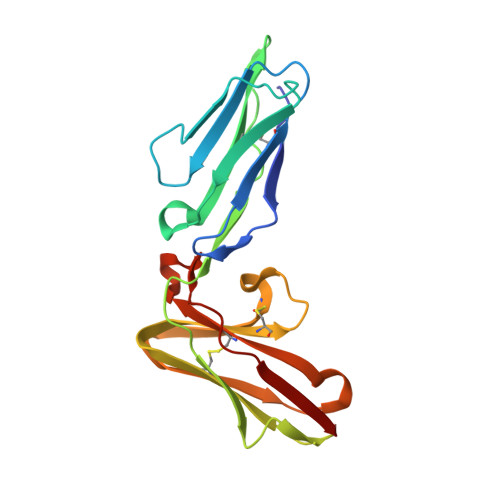Crystal structure of leukocyte Ig-like receptor LILRB4 (ILT3/LIR-5/CD85k): a myeloid inhibitory receptor involved in immune tolerance
Cheng, H., Mohammed, F., Nam, G., Chen, Y., Qi, J., Garner, L.I., Allen, R.L., Yan, J., Willcox, B.E., Gao, G.F.(2011) J Biological Chem 286: 18013-18025
- PubMed: 21454581
- DOI: https://doi.org/10.1074/jbc.M111.221028
- Primary Citation of Related Structures:
3P2T - PubMed Abstract:
The myeloid inhibitory receptor LILRB4 (also called ILT3, LIR-5, CD85k), a member of the leukocyte immunoglobulin-like receptors (LILRs/LIRs), is an important mediator of immune tolerance. Up-regulated on tolerogenic dendritic cells, it has been shown to modulate immune responses via induction of T cell anergy and differentiation of CD8(+) T suppressor cells and may play a role in establishing immune tolerance in cancer. Consequently, characterizing the molecular mechanisms involved in LILRB4 function and in particular its structure and ligands is a key aim but has remained elusive to date. Here we describe the production, crystallization, and structure of the LILRB4 ectodomain to 1.7 Å using an expression strategy involving engineering of an additional disulfide bond in the D2 domain to enhance protein stability. LILRB4 comprises two immunoglobulin domains similar in structure to other LILRs; however, the D2 domain, which is most closely related to the D4 domains of other family members, contains 3(10) helices not previously observed. At the D1-D2 interface, reduced interdomain contacts resulted in an obtuse interdomain angle of ∼107°. Comparison with MHC class I binding Group 1 LILRs suggests LILRB4 is both conformationally and electrostatically unsuited to MHC ligation, consistent with LILRB4 status as a Group 2 LILR likely to bind novel non-MHC class I ligands. Finally, examination of the LILRB4 surface highlighted distinctive surface patches on the D1 domain and D1D2 hinge region, which may be involved in ligand binding. These findings will facilitate our attempts to precisely define the role of LILRB4 in the regulation of immune tolerance.
- CAS Key Laboratory of Pathogenic Microbiology and Immunology, Institute of Microbiology, Chinese Academy of Sciences, Beijing 100101, China.
Organizational Affiliation:

















